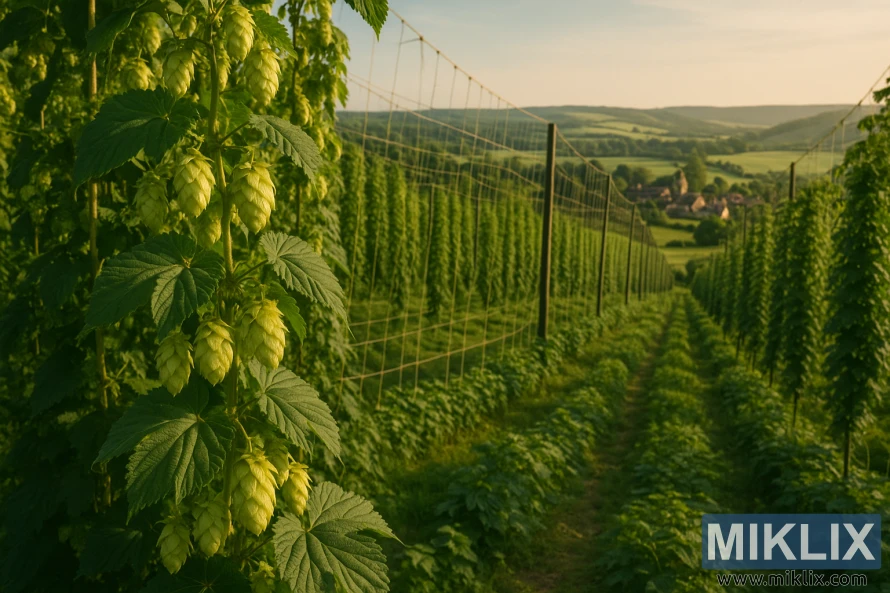Image: Sussex Hop Fields
Published: August 7, 2025 at 3:08:51 PM UTC
Last updated: September 27, 2025 at 9:04:27 AM UTC
A golden-lit Sussex hop field with swaying bines, detailed hop flowers, and a village in the hills, reflecting traditional English hop farming heritage.
The image captures the timeless beauty of a traditional English hop field set in the rolling hills of Sussex, bathed in the golden glow of late afternoon sunlight. In the immediate foreground, the hop bines climb gracefully upward, their sturdy stems entwined around twine strung taut across tall wooden poles. The hop cones themselves hang in clustered abundance, pale green with hints of yellow, their overlapping bracts forming delicate, papery textures that invite closer inspection. Each cone seems to shimmer as the light catches its velvety surface, suggesting both fragility and richness, the hidden lupulin glands within promising the complex flavors and aromas that brewers have cherished for centuries. The large, jagged-edged leaves surrounding the cones add contrast in both texture and hue, their darker green shades providing a lush backdrop for the paler cones that represent the culmination of the season’s labor.
As the eye moves into the middle ground, the orderly rows of trellises extend into the distance, forming a rhythmic pattern of vertical lines that structure the vast hop yard. This lattice of poles and wires, though simple in design, is crucial for supporting the rapid growth of hop plants, which can climb upwards of 20 feet in a single season. The symmetry of the rows leads the gaze down a central path, a dirt track worn smooth by farmers who have walked it countless times to tend to their plants. This sense of order contrasts with the organic, almost unruly exuberance of the bines themselves, whose tendrils reach and curl in every direction, embodying the relentless vitality of the hop plant. It is a marriage of human ingenuity and natural energy, a balance that has defined hop farming in England for generations.
In the background, the field rolls gently into the distance, giving way to the soft undulations of the Sussex countryside. Nestled among these hills lies a quaint village, its cluster of cottages and a church steeple rising subtly above the treeline. The presence of the village anchors the image in a lived landscape, reminding the viewer that hop farming is not only an agricultural endeavor but also a cultural tradition tied to the rhythms of rural English life. The distant fields and hedgerows blend seamlessly into the horizon, creating a pastoral vista that feels timeless, unchanged for centuries save for the quiet hum of modern farming techniques that may now support it.
The golden sunlight streaming across the scene enriches every detail. It bathes the hops in warmth, turning the cones into almost translucent jewels that glow against the darker greens of the leaves. Shadows fall long and soft, emphasizing texture and depth, while a gentle breeze stirs the bines, creating subtle movements that suggest both tranquility and vitality. This light transforms the hop yard from a mere agricultural site into a place of quiet reverence, where nature’s cycles and human stewardship converge in harmony.
Altogether, the photograph encapsulates not only the physical beauty of the hop field but also its symbolic significance. It represents centuries of English brewing heritage, where hops like Fuggle, Goldings, or more modern varieties have been cultivated to lend their distinctive character to ales enjoyed both locally and abroad. It evokes the patience and care of the farmers who nurture these plants through the seasons, the anticipation of harvest, and the brewing traditions that depend on such ingredients. More than a snapshot, it is a portrait of place and purpose, where the land itself plays as vital a role in the brewing process as any kettle, barrel, or recipe.
The image is related to: Hops in Beer Brewing: Sussex

